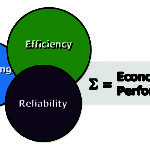Utility companies continue to face considerable margin pressures that stem from a number of challenges. An overall weakness in the commercial market, a flat and fragile residential market, modernization costs with limited availability of capital, and a higher level of volatility in energy costs all continue to affect profitability.
Although the impact of these factors may be magnified by the recession, they are likely to persist throughout a recovery. Also, rate changes that may lessen these impacts are available in some cases, but regulators’ bias to limit further economic pressure on rate payers is reducing the overall opportunity and size of any rate relief.
In response, many utility companies have established some form of margin improvement programs that include a portfolio of cost optimization, process optimization, and revenue management. Given the challenging market conditions, these efforts mostly focus on internal programs that can deliver predictable results, limit the need for significant operational changes, and have a proven track record of success.
Each program lever has its advantages and limitations. Executives must balance maximizing cost reductions (without eroding operational performance) and maximizing operational efficiency (without taking on unexpected change, costs, and risks). This portfolio approach often uses expected returns as a way to decide what to do and which efforts are most important.
At the highest level, levers that can affect the entire revenue line have the potential to create a greater impact than cost initiatives. For example, if a utility operates its business with variable costs at 15% to 20% of revenue, 1 percentage point of revenue gain would equate to 5 points of cost reduction. To match this return, cost optimization programs will eventually cut into operational muscle.
Using the example above, programs that can improve revenue performance by 1 point would give business leaders both significant financial value and extraordinary flexibility to attack costs in a highly targeted way while avoiding risk or forced operational changes. Is reducing revenue leakage to 2% to 3% good enough? What would an additional 1 to 2 points of revenue recovery mean to your financial performance?
Utility companies have a limited ability to affect the external market, so the best option is to maximize revenue from current operations. That’s why most utility companies have put in place efforts to address credit and collections and bad debt risk, and provided sampled-based billing analytics to reduce billing errors. These revenue assurance efforts have, in the majority of cases, helped to reduce revenue leakage to approximately 3%.
Using a simple model, a $1 billion revenue stream realizes $30M of leakage at 3%. Recognizing that no leakage is impossible, what should the target be? In complex telecom operations, most providers have been able to reduce leakage from 3% or more down to 1% to 2% in mature operations.
Utilities need to answer key questions that, in part, directly address revenue management needs, revenue recovery expectations, and the belief that tools built in a different sector (telecommunications) have sufficient relevance to utility operations. These include:
- Are my existing tools and practices sufficient to deliver an additional 1 to 2 points of revenue recovery?
- Can I benefit from a more proactive, systematic capability—and can it produce 1 to 2 points of revenue recovery?
- Do I believe that tools and practices proven in the telecom sector have sufficient relevance to my business such that I can begin testing their applicability and productivity?
The possible revenue gains are tantalizing. But they require a different analytic model for most utilities. How do utilities embrace the new model while appropriately kicking the tires on the approach itself?
In some cases, enterprises need to make substantial investments with the expectation, but not the proof, that the investment will pay off. The financial pressure on margins may abate but is unlikely to stop altogether.
As a result, utility companies are actively engaged in a range of activities with the goal of reducing the effects of weak demand, greater uncertainty in energy costs, increased capital costs, and stagnant rate cases. Among these efforts, a rigorous revenue assurance capability is likely to produce the greatest immediate and long-term return, as it can produce 1 to 2 points of revenue recovery through a single, unified investment.
—Victor Milligan is chief strategy and marketing officer at Martin Dawes Analytics, a leading global, data-driven process analytics software provider.









